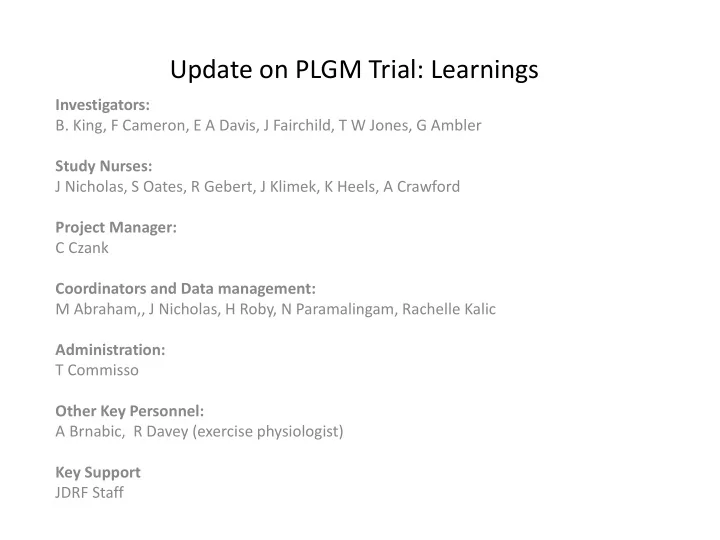

Update on PLGM Trial: Learnings Investigators: B. King, F Cameron, E A Davis, J Fairchild, T W Jones, G Ambler Study Nurses: J Nicholas, S Oates, R Gebert, J Klimek, K Heels, A Crawford Project Manager: C Czank Coordinators and Data management: M Abraham,, J Nicholas, H Roby, N Paramalingam, Rachelle Kalic Administration: T Commisso Other Key Personnel: A Brnabic, R Davey (exercise physiologist) Key Support JDRF Staff
Pathway to an Artificial Pancreas: Feedback control of insulin delivery A.Kowalski
Low glucose suspend study 200 Sensor 150 Glucose (mg/dL) 100 50 0 Switch off
CGM Cost-effectiveness Analysis: Sensor Augmented LGS Pump vs Standard Insulin Pump
Next Question: Can hypoglycaemia be predicted and prevented with sensor-augmented pump therapy and an imbedded algorithm? • Predictive Low Glucose Management (PLGM) System • Suspend before Low • SmartGuard TM
Australian Paediatric Diabetes Technology Research Group (JDRF CRN) Stage 1 : In-Clinic studies Stage 2 : RCT Home studies
Predictive Low Glucose Management System Algorithm : Calculates the rate of decline in sensor glucose. Predictive Horizon of 30 minutes 5.5 30 4.1 Modifiable features : Hypoglycaemic threshold : 3.9mmol/L 5.5 30 3.9 Pump resumption : 2 hour fixed suspend or if auto-resumption parameters are met
In Clinic Studies PLGM off Exercise Completed 2014 PLGM on PLGM off SC insulin bolus PLGM on PLGM off ↑Basal PLGM on
Positive Outcomes • Demonstrated the feasibility of performing protocols in multiple sites • Increased individual capacity of individual sites and of trial coordination • Enhanced collaboration and track record of such • Junior training in clinical research • Engagement of other investigators and disciplines: exercise, health economic, psychologist • Interesting results and contributions: presentations and publications
Multisite RCT: in progress • Predictive Insulin Suspend vs Sensor Augmented Pump Therapy • Primary Outcome: Time spent with Glucose Value <3.3mmol/l as measured by CGM • Adolescents • Total number = 175 , 6 months
Learnings 1. General 2. Specific for technologies
Learnings: 1 General 1. Time 2. Flexibility 3. Staffing 4. Coordination 5. Ethics and Governance and contracts 6. Communications 7. Trial governance 8. Data-handling 9. Funder support
Flexibility • Hypoglycaemia unawareness • Quality of life and compliance information
Learnings: 2 Specific for technologies 1. New ground 2. Flexibility 3. Relationship to industry 4. Multifaceted approach and outcomes 5. Very large data sets 6. Clinician as well as patient dependant
INDUSTRY INDEPENDENT FUNDERS CLINICAL RESEARCH TEAMS PATIENTS
Outcome Measures for Technologies • Glycaemic – Aic – Variability – Hypoglycemia • Events • CGM defined • Burden – Of the use of the technology – Of diabetes, hypoglycaemia fear, quality of life • Economic – Funders – Patients
Improvements • Contract management • Communications and face to face meetings • Data management
Reasons for success • Funding for Clinical Research: CRN • Strong collaborative sites and investigators • Strong interest from Type 1 community • International support • Unrestricted support from industry
Recommend
More recommend